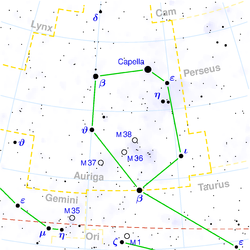Epsilon Aurigae
| Observation data Epoch J2000 Equinox J2000 |
|
|---|---|
| Constellation | Auriga |
| Right ascension | 05h 01m 58.13245s |
| Declination | +43° 49′ 23.9059″ |
| Apparent magnitude (V) | 2.98 |
| Characteristics | |
| Spectral type | F0 Iab (or II-III) + ~B5V |
| U−B color index | +0.30 |
| B−V color index | +0.54 |
| R−I color index | 0.45 |
| Variable type | Algol variable |
| Astrometry | |
| Radial velocity (Rv) | –2.5 km/s |
| Proper motion (μ) |
RA: −0.86±1.38 mas/yr Dec.: −2.66±0.75 mas/yr |
| Parallax (π) | 1.53 ± 1.29 mas |
| Distance | approx. 2,000 ly (approx. 700 pc) |
| Absolute magnitude (MV) | -9.1 |
| Details | |
| ε Aur A | |
| Mass | 2.2-15 M☉ |
| Radius | 135-190 R☉ |
| Luminosity (bolometric) | 37,875 L☉ |
| Surface gravity (log g) | ≲ 1.0 cgs |
| Temperature | 7,750 K |
| Rotational velocity (v sin i) | 54 km/s |
| ε Aur B | |
| Mass | 6 - 14 M☉ |
| Radius | 3.9±0.4 R☉ |
| Surface gravity (log g) | 4.0 cgs |
| Temperature | 15000 K |
| Orbit | |
| Period (P) | 9896.0±1.6 d |
| Semi-major axis (a) |
18.1+1.2 −1.3 AU |
| Eccentricity (e) | 0.227±0.011 |
| Inclination (i) | 89° |
| Longitude of the node (Ω) | 264° |
| Periastron epoch (T) | MJD 34723±80 |
|
Argument of periastron (ω) (secondary) |
39.2±3.4° |
|
Semi-amplitude (K1) (primary) |
13.84±0.23 km/s |
| Other designations | |
| Data sources: | |
|
Hipparcos Catalogue, Bright Star Catalogue (5th rev. ed.), 9th Catalog of Spectroscopic Binary Orbits, Variable Star Index (VSX) |
|
| Database references | |
| SIMBAD | data |
Epsilon Aurigae (ε Aur, ε Aurigae) is the Bayer designation for a star in the northern constellation of Auriga. It is traditionally known as Almaaz, Haldus, or Al Anz. Epsilon Aurigae is an unusual eclipsing binary system comprising an F0 supergiant and a companion which is generally accepted to be a huge dark disk orbiting an unknown object, possibly a binary system of two small B-type stars. About every 27 years, Epsilon Aurigae's brightness drops from an apparent visual magnitude of +2.92 to +3.83. This dimming lasts 640–730 days. In addition to this eclipse, the system also has a low amplitude pulsation with a non-consistent period of around 66 days. The distance to the system is still a subject of debate, but modern estimates place it approximately 2,000 light years from Earth.
Epsilon Aurigae was first suspected to be a variable star when German astronomer Johann Heinrich Fritsch observed it in 1821. Later observations by Eduard Heis and Friedrich Wilhelm Argelander reinforced Fritsch's initial suspicions and attracted attention to the star. Hans Ludendorff, however, was the first to study it in great detail. His work revealed that the system was an eclipsing binary variable, a star that dims when its partner obscures its light.
Epsilon Aurigae's eclipsing companion has been subject to much debate since the object does not emit as much light as is expected for an object its size. As of 2008, the most popularly accepted model for this companion object is a binary star system surrounded by a massive, opaque disk of dust; theories speculating that the object is a large, semitransparent star or a black hole have since been discarded.
Although the star is easily visible to the naked eye, Johann Fritsch's 1821 observations suggest he was the first to notice that the system was a variable. Eventually, from 1842 to 1848, German mathematician Eduard Heis and Prussian astronomer Friedrich Wilhelm Argelander began observing it once every few years. Both Heis' and Argelander's data revealed that the star had become significantly dimmer by 1847, attracting the full attention of both men at that point. Epsilon Aurigae had brightened significantly, and had returned to "normal" by the following September. As it attracted more attention, more and more data was compiled. The observational data revealed that Epsilon Aurigae did not just vary over a long period, but also experienced short-term variations in brightness as well. Later eclipses took place between 1874 and 1875 and, nearly thirty years later, between 1901 and 1902.
...
Wikipedia

